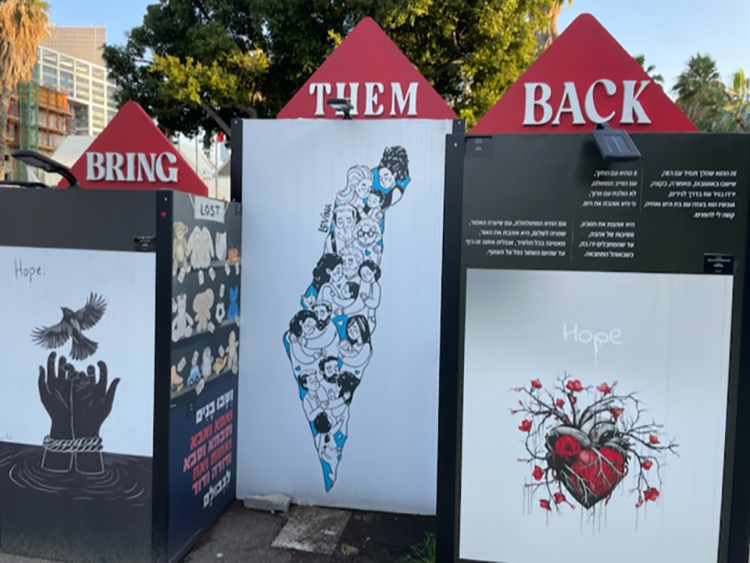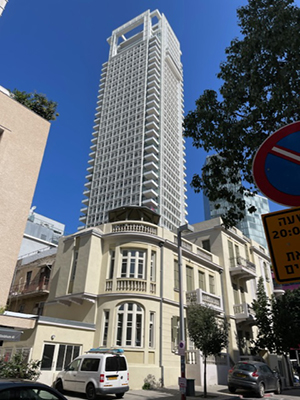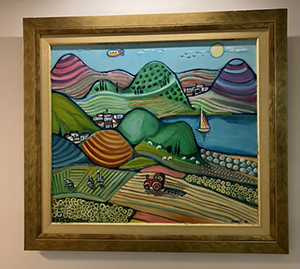
By Steve Kramer

KFAR SABA, Israel — Soon Israel will be warring with Hamas (and Hezbollah) for the fifth month! Although superficially Israelis are going about their business and (some) pleasure somewhat normally, everyone feels the pressure and the angst to some degree.
Among the most affected are those whose loved ones who have been killed or are captives of the Islamic terrorist Hamas fighters, those thousands who have been exiled from their homes in the north and south, and those whose relatives are fighting our enemies – often in harrowing circumstances.
But all Israelis, and not just Jewish citizens, feel the pressure that comes from seeing, hearing, and reading about the daily casualties and the damage being done to our society, financially and socially. So, as a diversion, Michal planned a day trip to Tel Aviv to take our minds off of the situation and to enjoy several hours away from tv, newspapers, and social media. (For the record, I avoid all social media with the exception of putting my articles on Facebook.)
Picking up our good friends in Ra’anana, we headed to the local train station and took a train to Petah Tikva. Why Petah Tikva, a typical larger city adjacent to Tel Aviv? Because at the station we could exit the train and walk to the adjacent Red Line Light Rail to Tel Aviv. This was our first time riding the new tram system, just one of the lines slated for Tel Aviv and surrounding towns. By taking the tram, which is underground in Tel Aviv, we were able to exit at the exact area we wanted, one of numerous stops in the city.

We walked out of the Allenby Road station (named for British Field Marshal Edmund Allenby, liberator of Jerusalem in the fall of 1917), a short distance from Lilienblum Street, where we made our first stop. The Lilienblum Street area is known to offer a wide selection of popular bars, restaurants, and small hotels. It’s part of the central nightlife area in the southern part of the city, between the end of trendy Rothschild Boulevard and Neve Tzedek, the oldest part of Tel Aviv. I was mostly interested in the architecture, which included beautifully restored buildings from a century ago and modern skyscrapers, of which Tel Aviv has a mind-blowing number (more than 300 over 40 stories tall).
We soon entered Asif (harvest) the Culinary Institute of Israel, a very modern complex, dedicated to cultivating and nurturing Israel’s diverse and creative food culture. It features a cookbook related library, a photo gallery, a cafe, and more. We especially wanted to see the current exhibit of photos of soldiers enjoying the great food that Asif volunteer chefs have prepared for hundreds of soldiers: the Front Line Initiative. Asif even catered a wedding near the front. There is also a current Open Kitchen Project for cooks displaced by the war. We noticed that our young friend, James Beard-winning chef Michael Solomonov of Philadelphia, is part of the Asif team.

After enjoying delicious pastries and coffee, we started walking towards the Gallery of International Naïve Art – GINA. After enough “sightseeing” on Tel Aviv streets we hailed a taxi to reach the gallery, which is near the foot of Dizengoff Street (named for Tel Aviv’s first mayor). Gallery founder and owner Dan Chill described how the charm of Naïve Art attracts many patrons, “…primarily through its ability to simply touch the deepest points of our hearts and souls. Despite its popularity, Naïve Art doesn’t have an academic or theoretical definition. Naïve Art is characterized as the technique of refreshing an innocent, idealistic point of view on everyday life, via a charming use of bright colors and a child-like perspective. When exposed to Naïve Art paintings, we are often reminded of our childhood, perceiving the world in strong contrasts and glowing colors.” Decades ago in the US, a famous naïve artist was Grandmother Moses.
Dan describes his gallery as unique, the only gallery in the world that seeks, gathers and exhibits paintings of more than 100 Naïve artists from a score of nations all over the globe. Lately, since the corona pandemic and now the war, foot traffic has markedly dropped. Dan had decided to close shop after more than a decade, but an outpouring of support – including monetary – has resulted in keeping the gallery open for at least several months (hopefully more), due to the attention the announced closing engendered. We bought a beautiful naïve landscape from GINA about ten years ago, which happens to be by a local painter, a retired IDF officer. It’s something we never tire of.
Time for lunch! We walked a short distance to Ben Yehuda Street where the “Dosa Bar” is located. A vegan Indian restaurant, it features the eponymous dosa, a crispy, crepe-like street food from southern India. The dosas are of different types, ingredients, and accompaniments. We accompanied our food (appetizer plus dosa) with delicious fruity drinks.
Fortified by our refreshments, we caught a bus to our last destination, one we visited a few months ago, Hostages Square. It’s located in the plaza in front of the Tel Aviv Art Museum and is “open” day and night. Our friends hadn’t been there yet, so it was a worthwhile visit for them and for us, because many of the “exhibits” have been changed.
There’s no difficulty finding English speakers in Hostages Square, Israeli and from abroad. Visitors who came to volunteer and support Israel mix with a stream of Israelis who come to see the poignant art installations and stalls selling shirts and stickers, which have become symbols of the struggle for the return of the hostages. Many visitors take the time to speak to the “regulars” there, relatives and close friends of the Israeli captives (dead and alive) who are still not home in Israel.
What we hadn’t seen before was a dance class led by a senior dance teacher, which we believe included many young dancers from local companies, plus aspiring ones. Their exertions provided a lively and positive atmosphere to the somber exhibits, perhaps typifying the atmosphere that pervades Israel today: sadness, anxiety, heightened energy, resoluteness, and unity.
Our next trip will be to Jerusalem, but because there will be an interruption in train service to add an additional rail line in the Tel Aviv area, we may drive or take a bus. In the meantime, Israel grittily keeps fighting our enemies in the north and south, hoping to be able to soon retrieve some or all of our captive Israelis, on the way to our decisive victory. There is no alternative to victory!
*
Steve Kramer is a freelance writer based in Kfar Saba, Israel. He may be contacted via steve.kramer@sdjewishworld.com